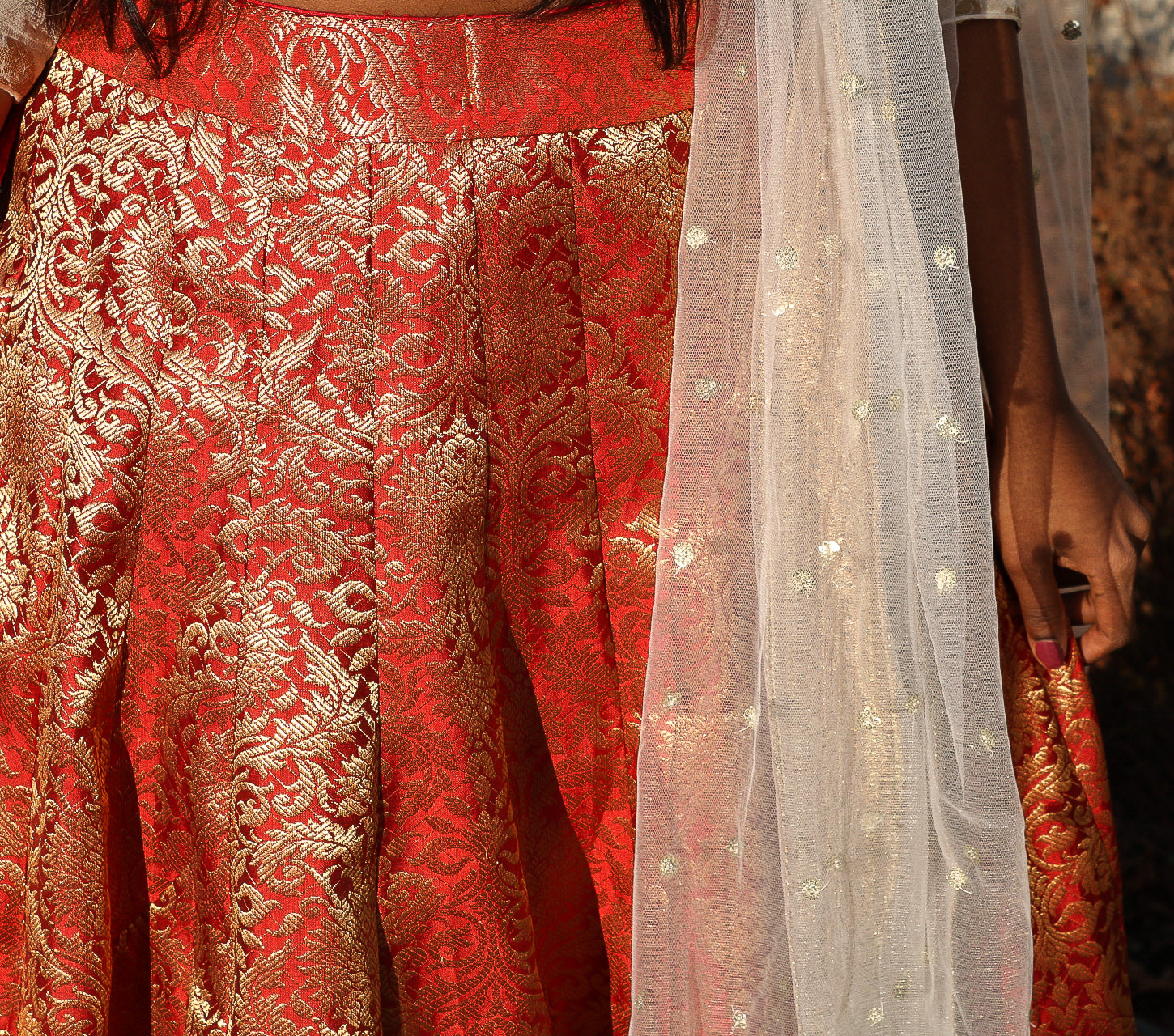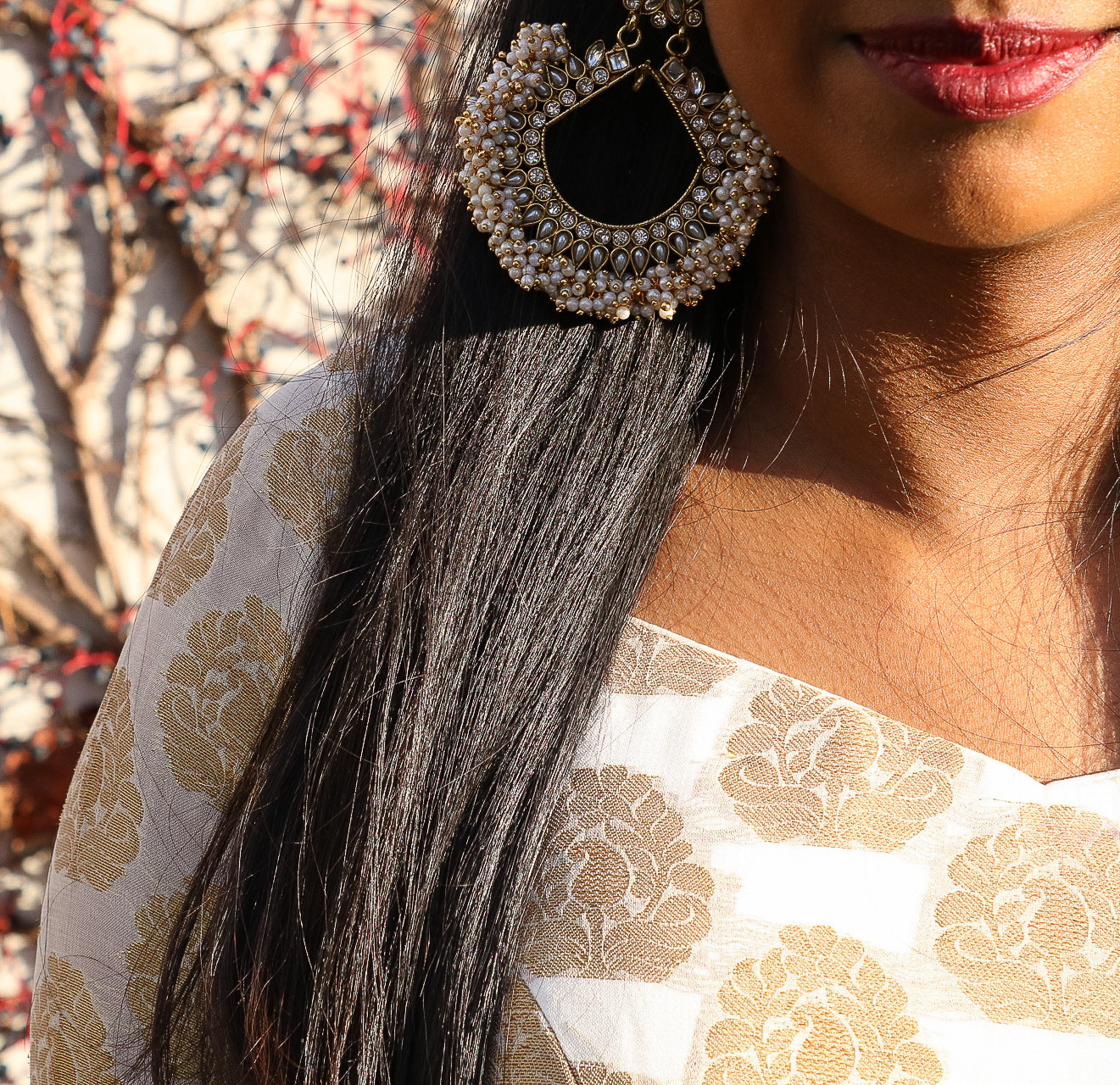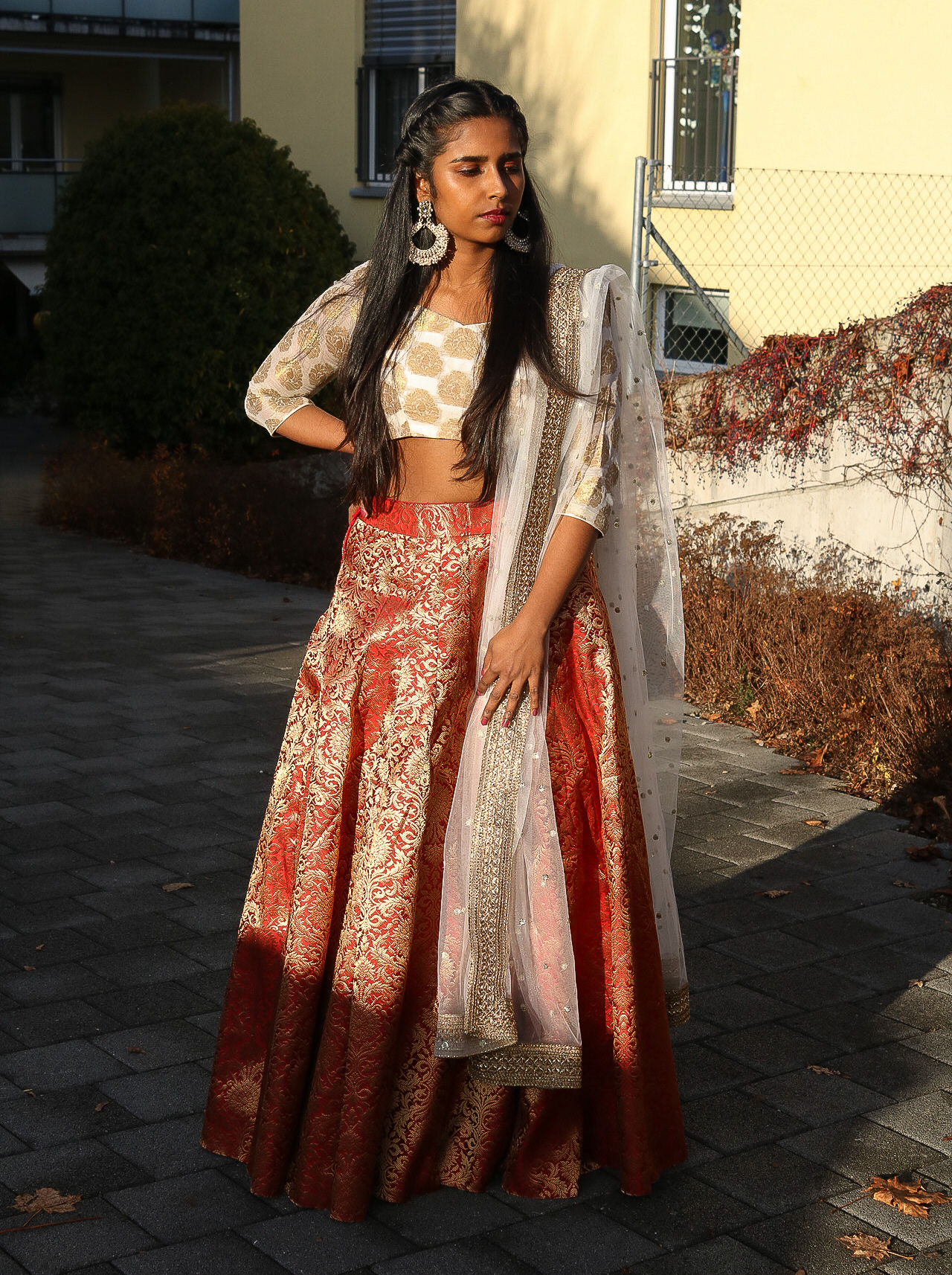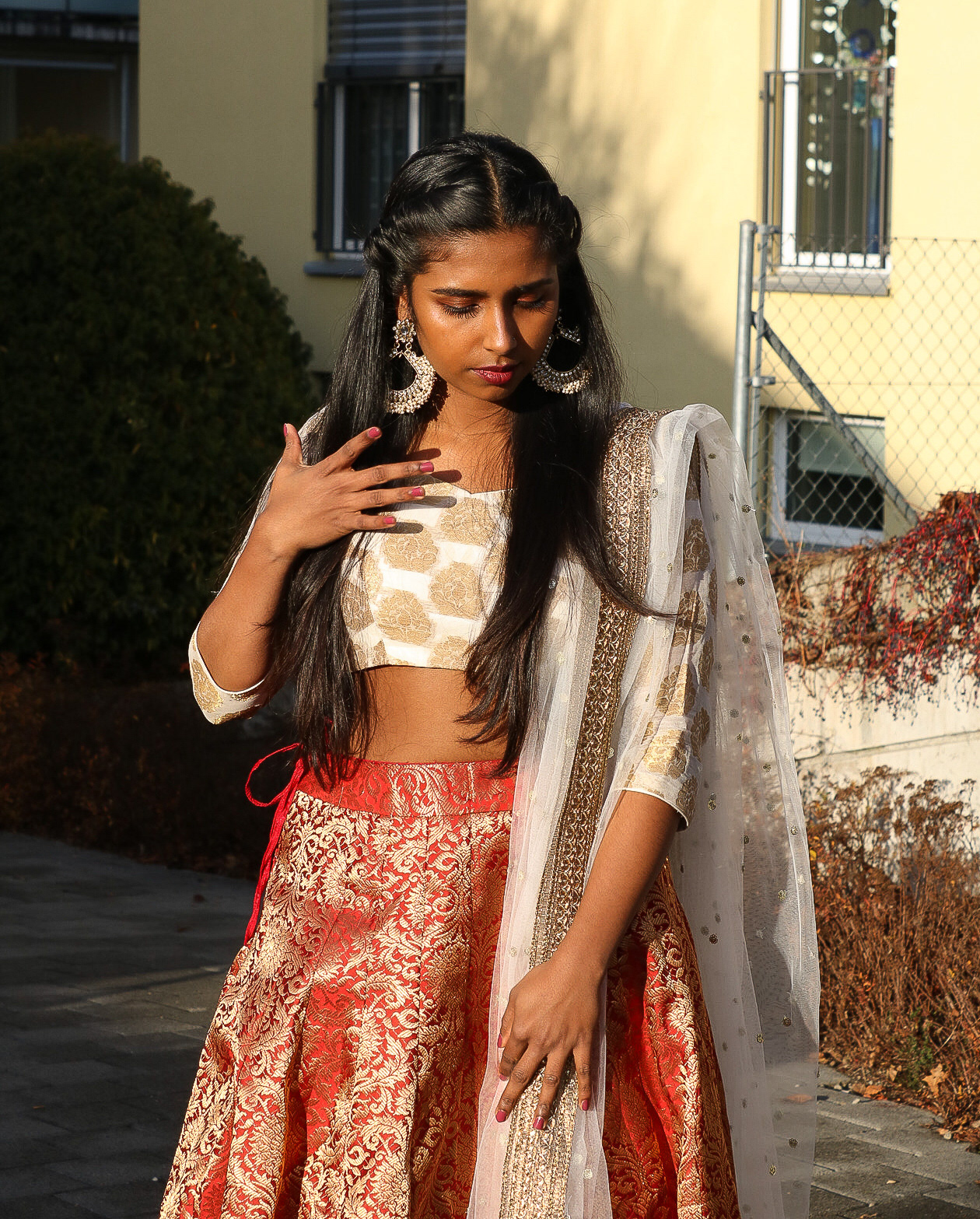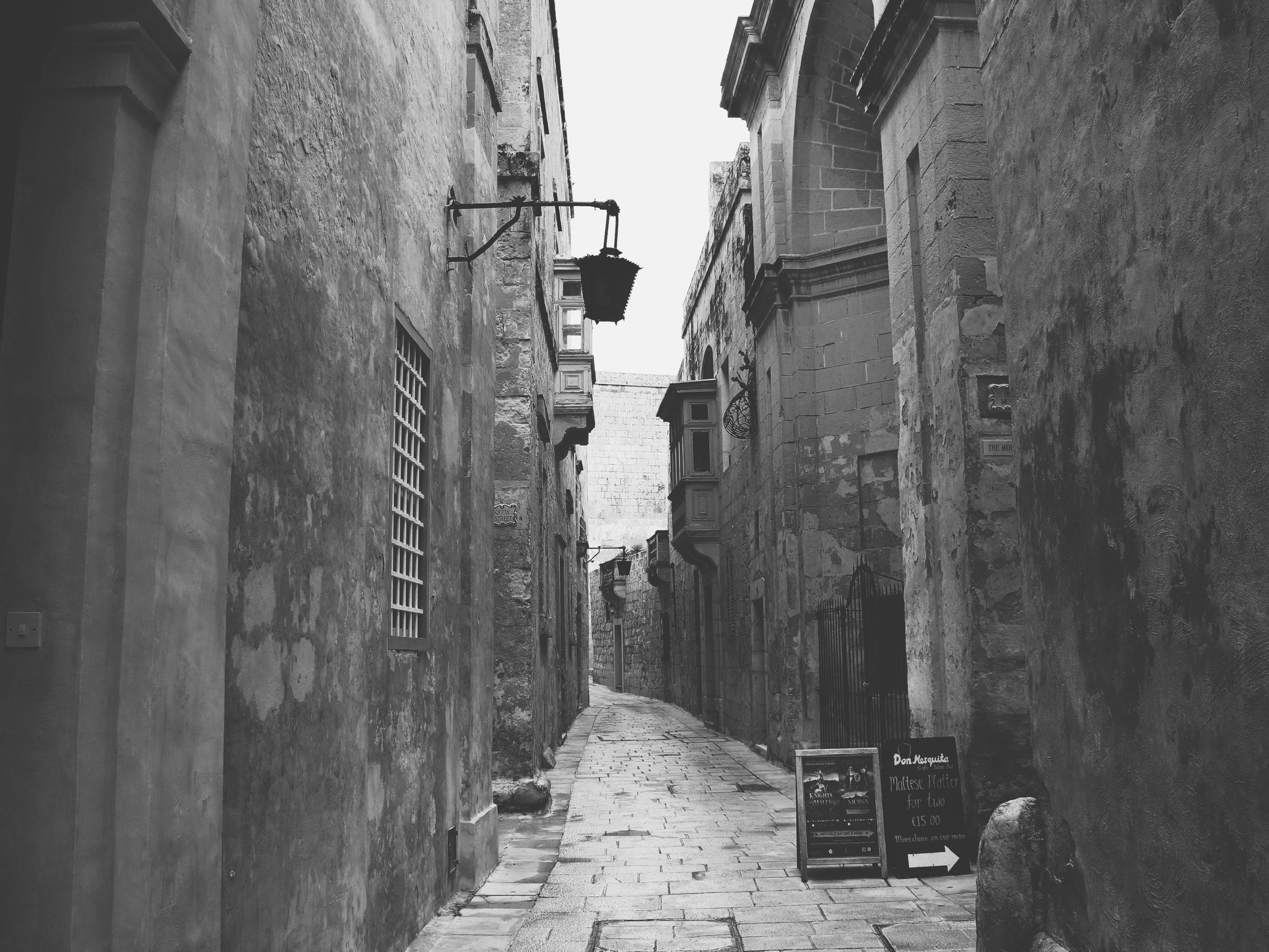For the immersive experience, we recommend visiting
the official webpage here: Fashion in Sri Lanka
INTRODUCTION
Photography and fashion form a solid relationship in today's digitization with the help of social media and technological progress. These combinations are used in today's economy to facilitate the transfer of culture and style. Emotions and knowledge are much easier to represent these days and the aim of this work will be to digitally present the experience, culture, and meaning of Sri Lanka's clothing.
The in-depth work looks at Sri Lanka's clothing and fashion culture. In order to get to know them better, we carried out photo shoots and presented images digitally on the website that was created for this work. They should not only serve the theoretical knowledge about the culture of clothing, but also contribute to the collection of practical experience.
The end products we create serve to accompany us for a while and to pass on knowledge. The end products exist in both digital and physical form, as a photo book. We selected five Sri Lankan clothing items for the photo sessions. The photoshoot images are identical in both physical and digital form for each style.
SARI & LEHENGA
The saree from South Asia is a sewn wrap skirt with a one-sided wrap on the shoulder for women. Saree is a traditional clothing that is still worn very frequently in everyday life in India, Sri Lanka, Bangladesh, Nepal and Pakistan. There are also holiday sarees. The Sri Lankan clothing has nothing to do with religion in the first place, but represents various festivals in Tamil culture.
There are many ways to wear a saree. They vary depending on the cultural area, so that the origin of the wearer can also be identified by the way in which the item of clothing is worn. In Gujarat (state in West India), for example, the end of the saree does not hang down at the back, but at the front. There are also clothes that have changed over time with modernization, such as the lehenga.
The saree consists of a rectangular fabric, about 0.8 m - 1.20 m wide and about 5 m - 7 m long, mostly seamless, with a more or less wide decorative border on the sides and / or on the ends of a different color. The fabric length can be divided into three zones. The paluv, the shoulder part that is mostly thrown over the left shoulder and is the most decorative, then the saree body (skirt), which can be both simple and very decorative, and lines the final decorative trim. Traditional sarees are made of cotton and are cheaper to produce. However, there are also high-quality sarees that are worn on special occasions and are made of silk, which are more complex and expensive to produce.
In the past, the only item of clothing for women was the length of the fabric, mostly white cotton. In this day and age, a t-shirt is sometimes worn. The upper body is protected from prying eyes by a tight T-shirt with short sleeves without a belly, called a choli.
However, both are mostly contemporary traditions and, aside from a few early Indian examples, most likely have Arab, European, mostly British influences. The modern clothing culture of the saree has changed at a reduced rate in the last couple of years. Depending on the person and personal taste, you can try out a number of variations and combine jewelry and dress.
In some transparent holiday sarees, the choli has been significantly reduced in size or replaced by a strapless bra since the last decades of the 20th century. 1
Lehenga (half saree) refers to a woman's garment cut to length on the northwest Indian subcontinent that is visually similar to a saree. As with the saree, there are everyday and festival lehenga.
The lehenga consist of a floor-length skirt, waist cuffs and wide hem edges as well as independent shoulder throws or veils. There is also a petticoat and a short-sleeved jacket (also known as choli). 2
«It has been part of Hindu tradition for a long time and is said to awaken the spiritual chakras of the human body.
According to Hindu culture, lehenga is used as suitable clothing and, on a spiritual level, also as sattvige clothing 3 (Purity / sacred clothing) viewed.» 4
Translated quote from https://en.wikipedia.org/wiki/Lehenga
THE PEACEFUL PARTY FASHION
In Sri Lanka one can recognize the occasion of the celebration through the clothes. However, since different festivals and customs take place in Switzerland, there may be different options in the country of origin. The clothes and make-up are different at every festival. This dress is called a saree and is worn on the 18th birthday party or holiday party. The saree is in the colors white and gray, and has the same colors on the top.
The color blue symbolizes peace.
Since this saree is a party look, other colors for the top would highlight better. A blue fabric patterned with animals should replace the gray top and be adjusted according to the body length. The saree itself is also called a cotton saree. The cost of cotton saris is around 50 Swiss francs. The blue fabric with peacock and cow patterns was bought in Sri Lanka and sent to Switzerland for customization. The price for the fabric itself is around 7 Swiss francs per meter. Each saree is a 6.0 to 7.0 m long piece of fabric that can be worn differently depending on the style or occasion. Without outside help with the composition of the saree it is difficult to put it on yourself.
Of course, jewelry also plays an important role. For this party look, the gray accent colors of the original top with silver jewelry have been replaced. A matching short chain, also known as a choker, as well as earrings, a silvery nose ring and bracelets are part of the traditional party look. To this day, silver is considered sacred and pure and is intended to highlight the style of clothing.




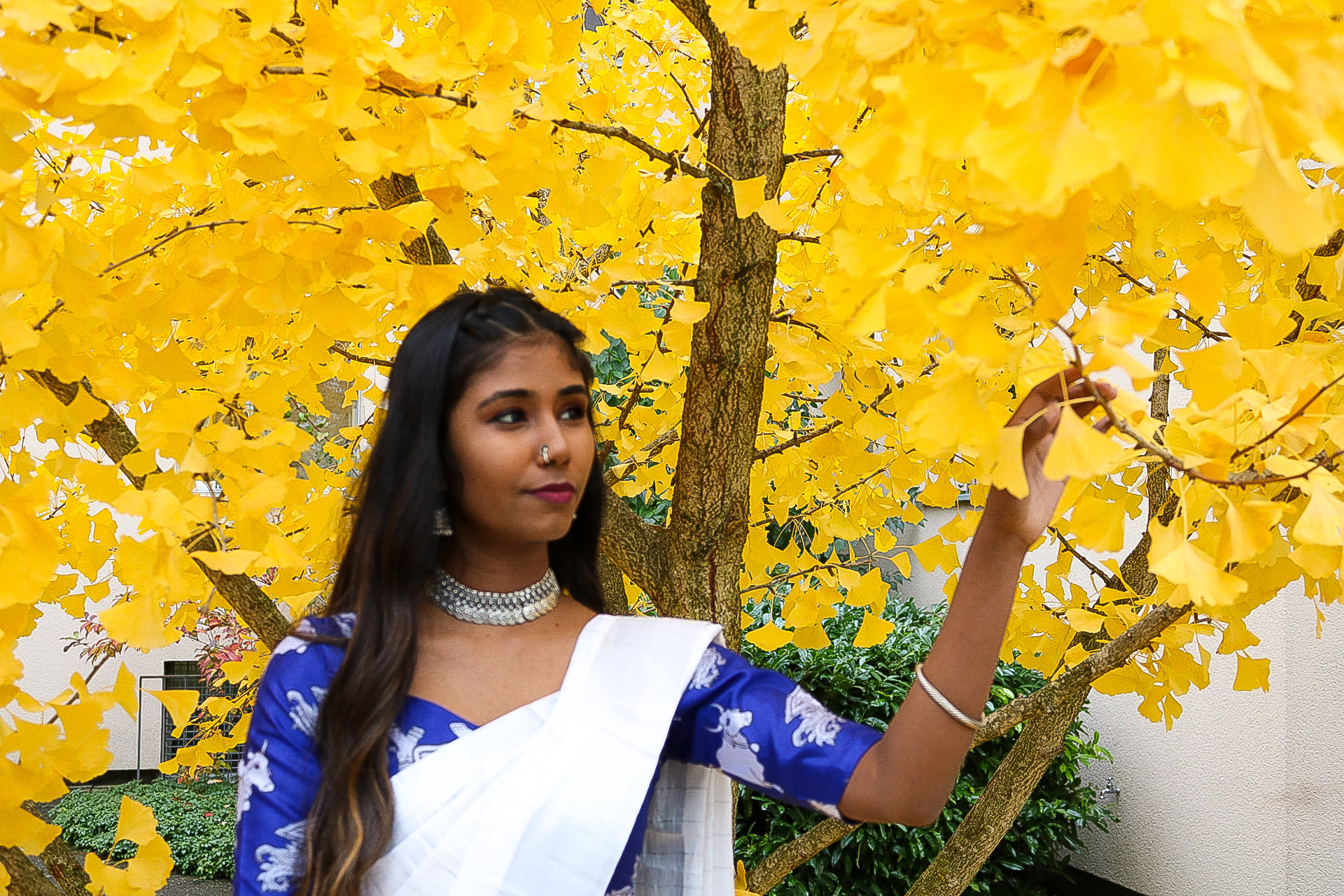





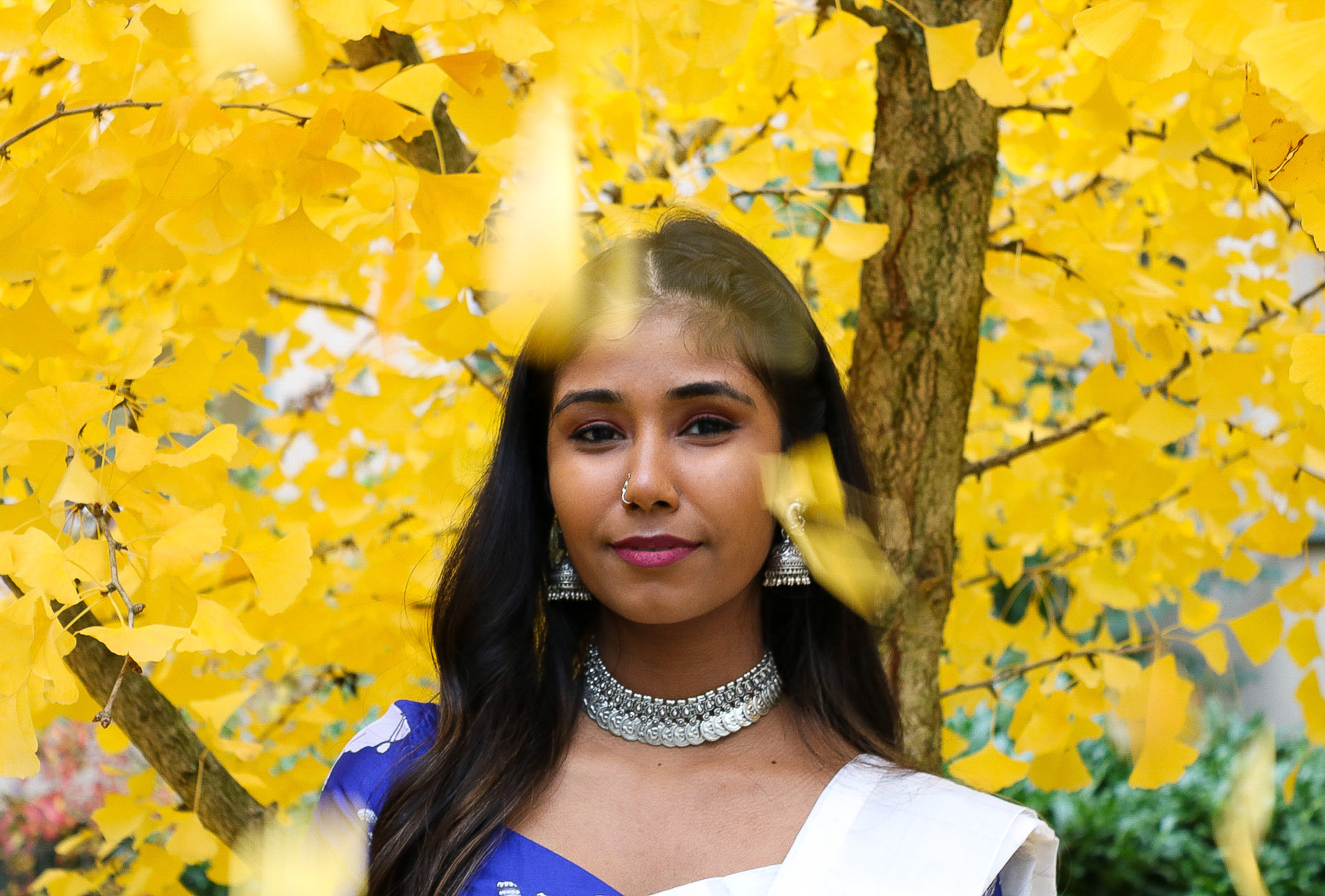













THE HOPEFUL TRADITIONAL FASHION
This style of clothing shows a wedding fashion. But these are also suitable for youth festivals. Depending on the saree and how you wear it, you can find out what kind of celebration you are attending. Most weddings take place in temples or rented halls with enough space for guests.
The color green symbolizes hope.
There are different types of jewelry in Sri Lanka depending on the type of clothing. Most traditional jewelry is gold plated. The color accents of the necklace (also called choker) and the earrings in green, gold and pink go well with this dress. Bracelets with the colors red wine and gold are also part of the clothing style.
The fabric was bought from Manjari, a clothing store in Oerlikon. Since the blouse is not made of the same fabric, it can be sewn separately from other fabrics. The total price for the saree and blouse is 100 Swiss francs. It was not easy to sew a top because a special design is implemented on the fabric. That is why the tops are often finely handcrafted.








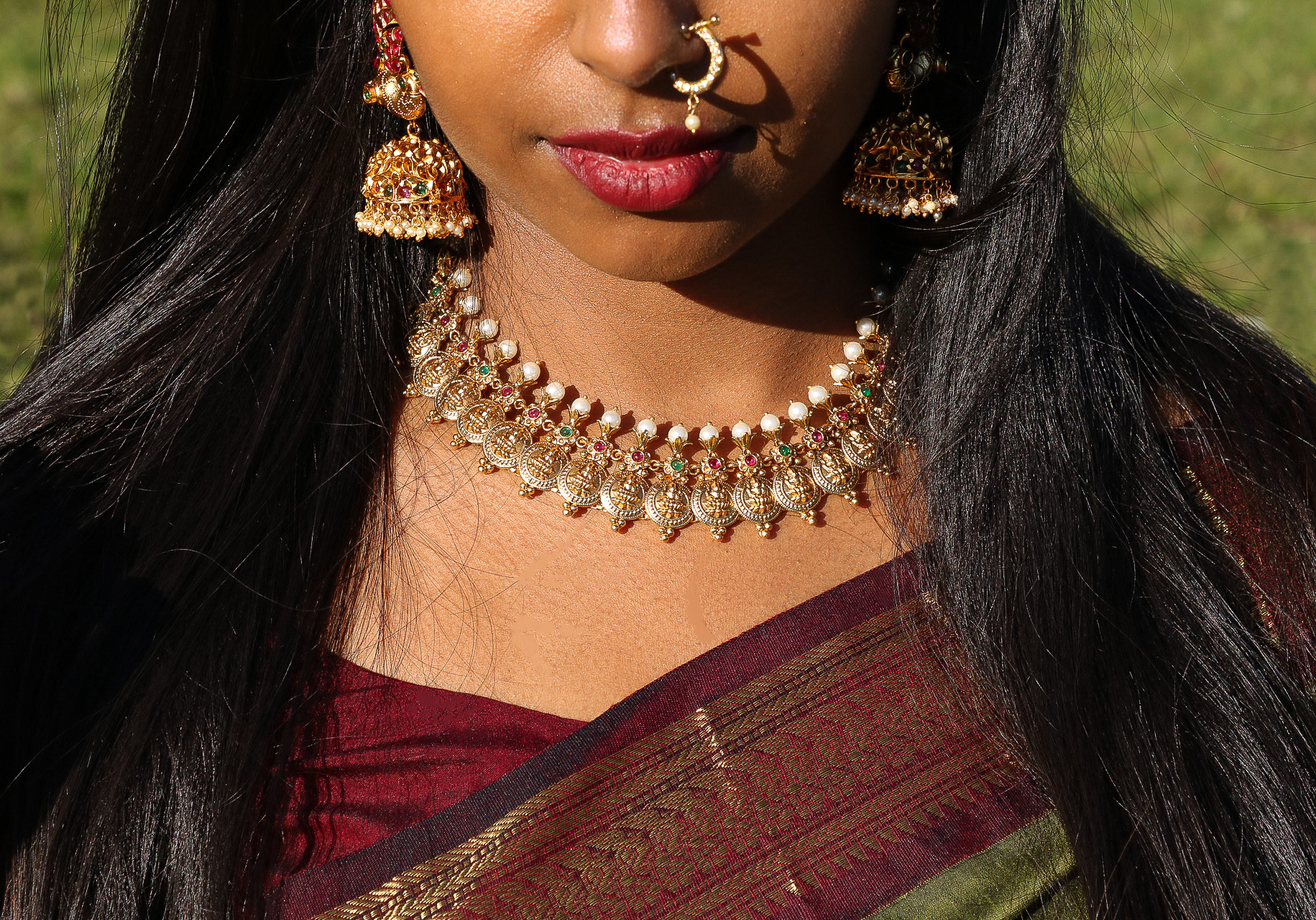











THE ENLIGHTENED MODERN FASHION
The modern saree look is worn here in an open saree instead of being folded over the shoulder. This saree can be worn to an invited wedding or birthday party.
The color yellow symbolizes enlightenment and is said to have a protective effect.
The blouse was sewn separately and the saree was ordered online in London. The fabric is made of cotton and the cost is around 60 Swiss francs. Due to the careful handwork and neat seams you can tie the blouse at the back and thus form a loop-like pattern.
Large gold-plated earrings are intended to enhance the look with the yellow accents of the saree. A gold-plated nose ring with white accents should also be part of the accessory. Here, however, a chain is omitted in order to focus on the larger jewelry.



















THE BOLD TRADITIONAL FASHION
The bold traditional look is worn for family weddings. Here, too, the saree was worn open and not folded over the shoulder. The color of the saree should come into its own with green and gold accents on the blouse and jewelry.
The color orange symbolizes courage and maturity.
The highly differentiated colors of the jewelry create an exciting look in conjunction with the saree and blouse. The wine-red earrings stand out optically and put the focus on the face. The face is also emphasized with the green chain with stones. The bracelets with the colors pink, green and gold are part of the clothing style. This traditional style of clothing also includes a gold hip band. The color green of the blouse as well as the jewelry should bring a certain balance and calming effect.
The saree is made of cotton and was bought online for around 60 Swiss francs from a well-known seller called VA Collection. The VA Collection sarees are very popular and are widely purchased by the Tamil community. The blouse was made for this style of clothing by Mayilcouture.







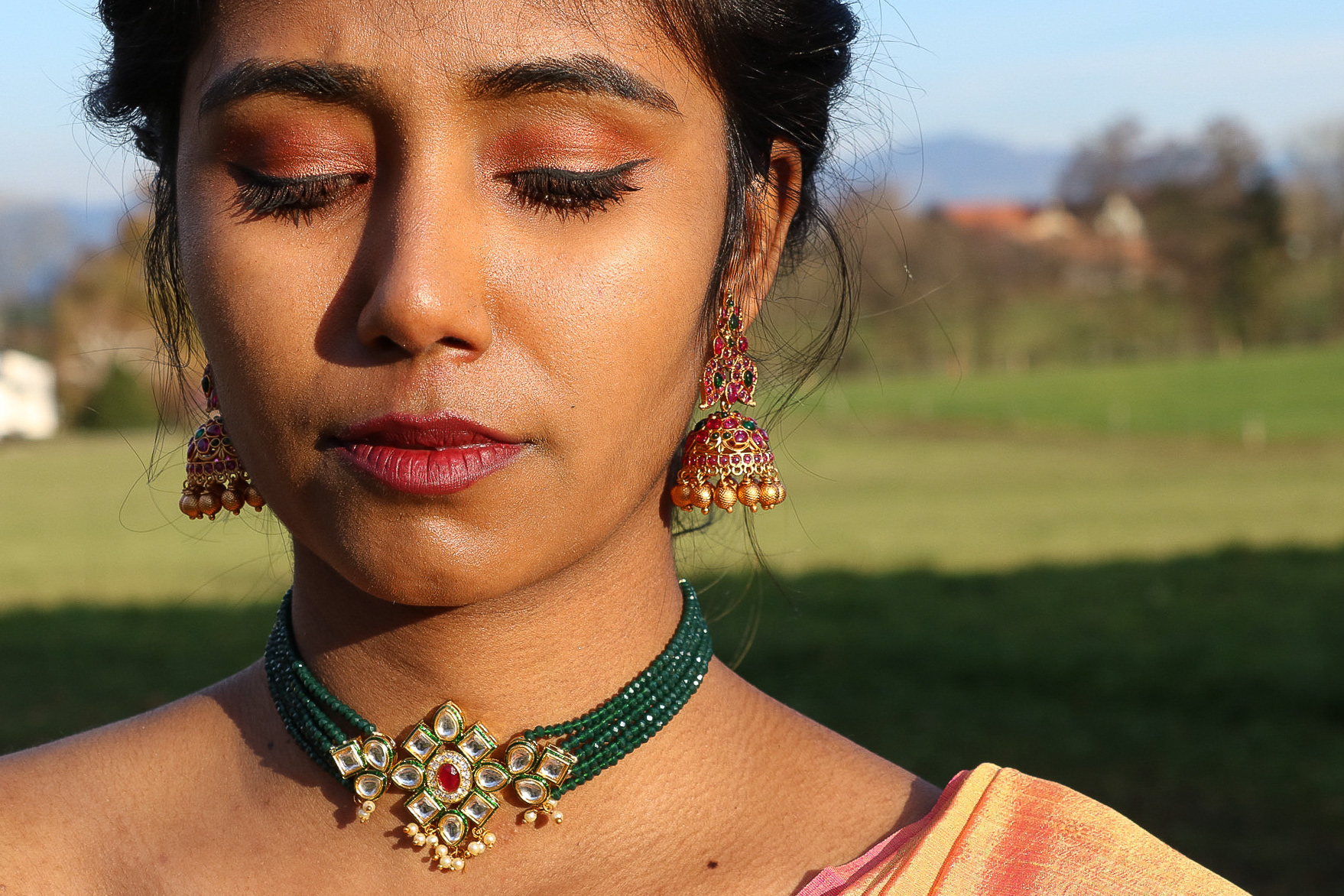


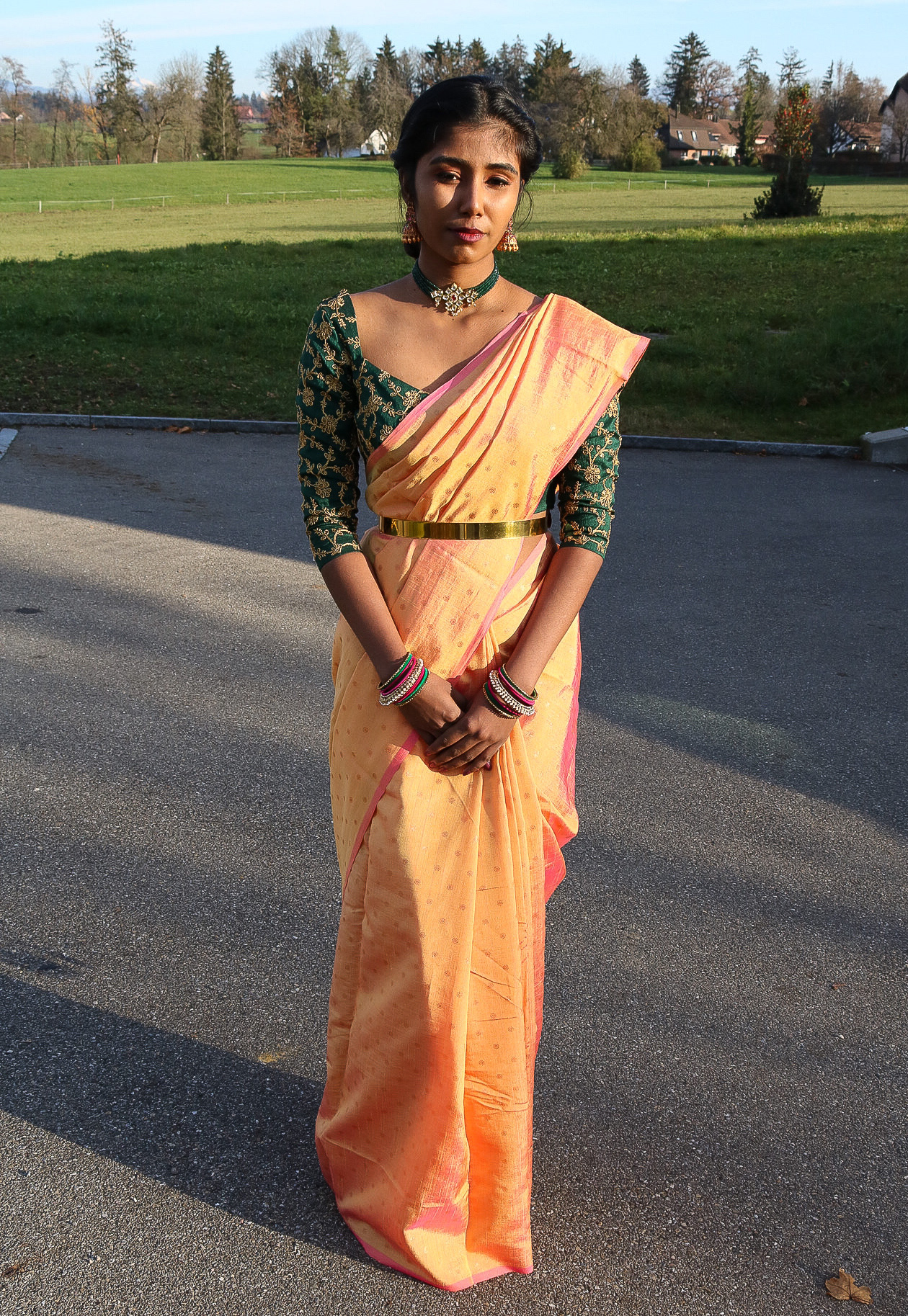
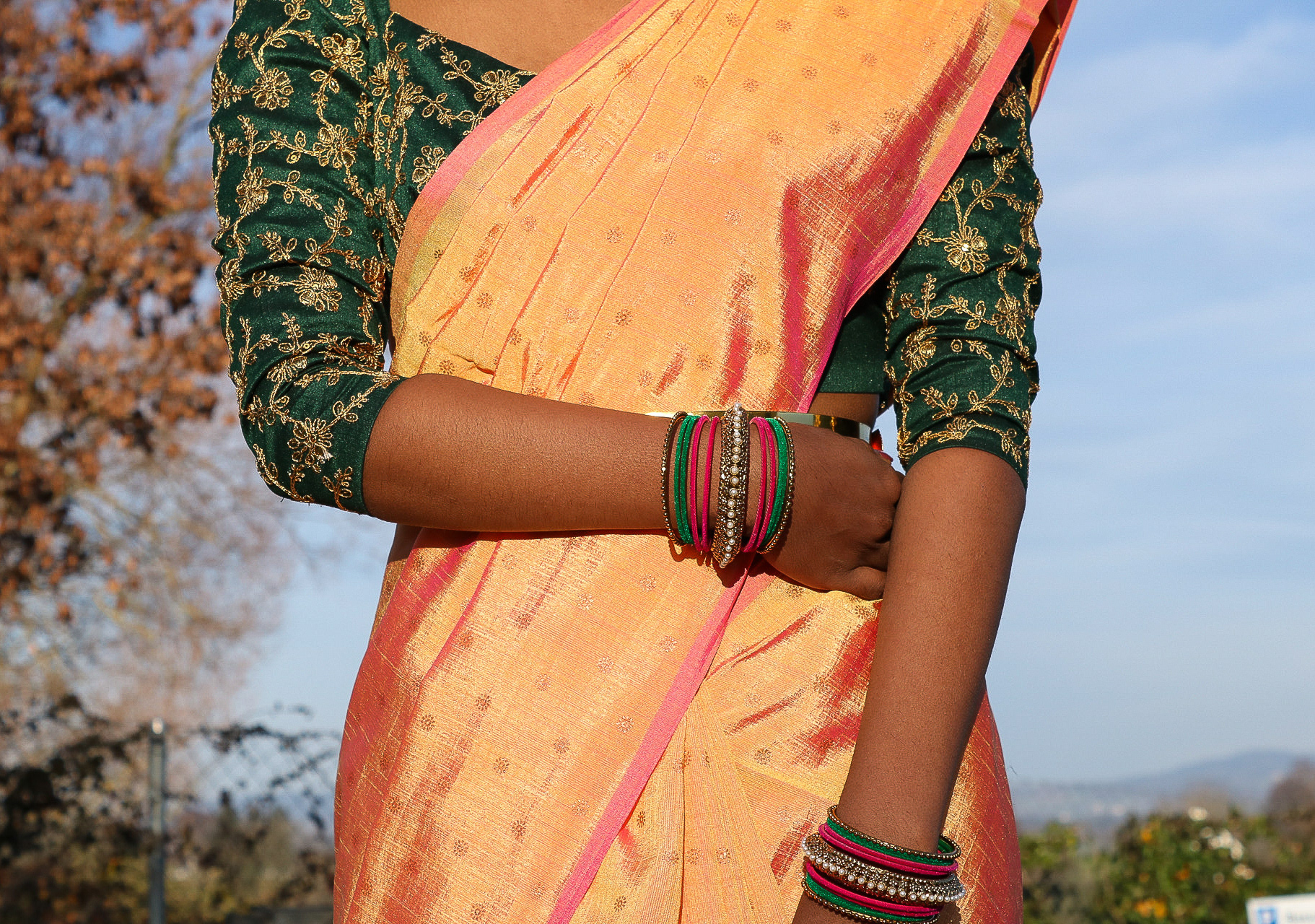







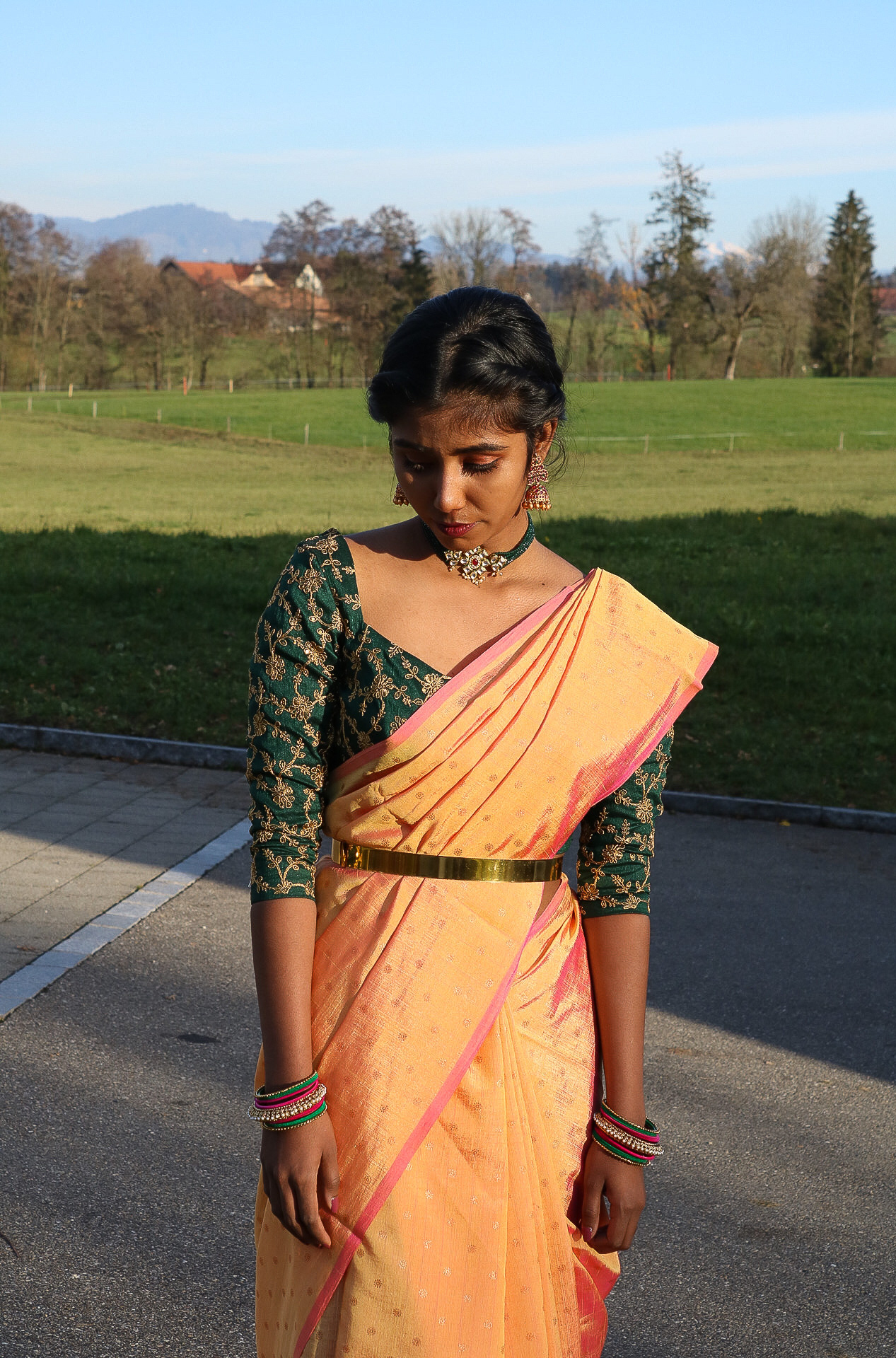
THE PURE COALITION FASHION
The lehenga (half saree) is made from different fabrics. Depending on the quality and type of the festival, this is specially made. The lehenga can be worn for any kind of celebration and is particularly popular with the younger generation.
The color white symbolizes purity.
The lehenga divided as a blouse and skirt can also be called a modern lehenga. A scarf can, but does not have to be, worn over the shoulder. The orange skirt with gold pattern is supposed to give the dress a certain rich and pure look. Due to the floral pattern on the blouse and the skirt, the two parts go well together. This lehenga was purchased, custom made and shipped directly from Mumbai, India. The cost is around 180 Swiss Francs.
Depending on the celebration, the jewelry can be adapted as desired. With large earrings, which are covered with white offset stones, the purity of the model should be emphasized. The focus here is also on the large earrings, which is why further pieces of jewelry are not used. The hair worn open should emphasize the earrings again.


